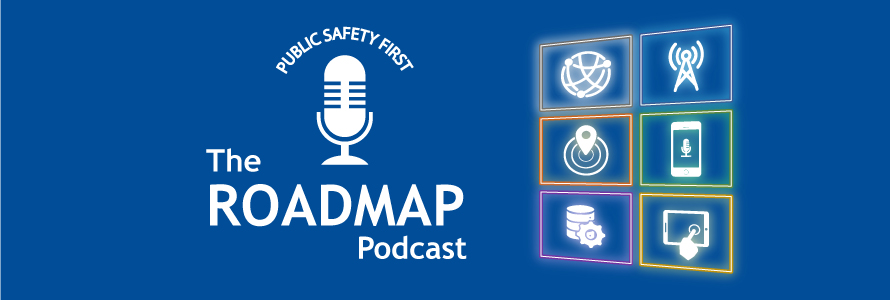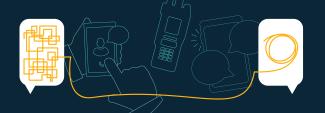Summary
In this episode, host Dave Buchanan sits down with FirstNet Authority Executive Director of Enterprise Strategy Jeremy Zollo to discuss the newly released FirstNet Authority Roadmap and what it means for public safety.
Guest
Dave Buchanan
FirstNet Authority Executive Director of Public Safety Advocacy
Jeremy Zollo
FirstNet Authority Executive Director of Enterprise Strategy
Transcript
Preview
Narrator: You're listening to Public Safety First, a podcast to help you learn about the First Responder Network Authority and how you can be part of the future of public safety technology.
And now your host, Dave Buchanan.
Dave Buchanan: Welcome to the Public Safety First podcast. Today we’re going to be discussing the recently released FirstNet Authority Roadmap, and I’m delighted today to be joined by my friend and colleague, Jeremy Zollo, the Executive Director of the FirstNet Authority’s Enterprise Strategy Division. Jeremy’s going to be sharing with us his work on this recently released Roadmap and the ongoing investment process. Welcome to the podcast, Jeremy.
Jeremy Zollo: Thanks, Dave. Glad to be here.
Narrator: You're listening to Public Safety First, a podcast to help you learn about the First Responder Network Authority and how you can be part of the future of public safety technology.
And now your host, Dave Buchanan.
Dave Buchanan: Welcome to the Public Safety First podcast. Today we’re going to be discussing the recently released FirstNet Authority Roadmap, and I’m delighted today to be joined by my friend and colleague, Jeremy Zollo, the Executive Director of the FirstNet Authority’s Enterprise Strategy Division. Jeremy’s going to be sharing with us his work on this recently released Roadmap and the ongoing investment process. Welcome to the podcast, Jeremy.
Jeremy Zollo: Thanks, Dave. Glad to be here.
Dave Buchanan: So you and I had an opportunity to work starting in 2014 on the state consultation process and the national consultation process where we engaged public safety at the federal, state, local, and tribal level to first develop our request for proposal that led to our network partner.
You and I worked together to lead the team that then consulted with those same organizations on our state plans that led to the network deployment in each of the 56 states and territories, and now you and I are working together on the engagement program on this Roadmap, which is really the guideline for our future investment with the network.
Let’s talk a little bit more about what that Roadmap is. What is it, and why did we decide to create a Roadmap?
Jeremy Zollo: Well, as we went through the acquisition process and got the network in place, created that partnership with AT&T, the Strategy Division started to focus on what was next for FirstNet. After we went through opt-in, through consultation, and all 50 states and six territories had signed up for the FirstNet network, we needed to figure out what was life after that, and then how do we find a transparent way to talk to public safety about the network itself, and then on top of that, how are we going to invest in that network over the next 20 plus years?
So the Roadmap really became a foundational document and a way for us to define the network, define what are the things that we need to focus on with public safety, and then find a way to continue to engage public safety and find out what’s important to them about the network – what areas, what needs do they have, what priorities do they see that we should take on as an organization to represent them as we make these investments along the way, hand-in-hand.
So we broke the Roadmap into six different domains. That way, we would have an ability to focus our conversations with public safety on what was important to them and for us to be transparent on how we define the network. So, we’ll touch on this I think a little bit later, but we broke it into six domains: the FirstNet core, coverage and capacity, situational awareness, voice communications, secure information exchange, and user experience.
Dave Buchanan: So for me, one of the most exciting aspects of the Roadmap work we’ve done here in 2019 is seeing and watching and understanding first responders’ engagement in this discussion.
For us at the First Responder Network Authority, the ability to really extract the most important elements from public safety on what they need in the network going forward in these particular areas has been really fruitful, and has really brought a lot of energy to the engagements we’ve had so far.
We were in Phoenix earlier this summer for our nationwide Roadmap Summit. You and I had a chance to participate in that. Share with us a little bit about what you saw there, and what we learned from public safety at that summit.
Jeremy Zollo: Yeah, so the most important thing that I took away from Phoenix was how the dialogue had changed. We were really good as an organization through consultation with understanding a state’s needs, understanding the disciplines within those states, but, to me, Phoenix really represented a shift to a nationwide focus.
You had over 100 participants from all the disciplines represented – police, fire, EMS, the 9-1-1 community, emergency management – and they came to talk about a nationwide network, as users of the network, or future users of the network, and they all rallied around the common goal of how do we make this nationwide network better, and not necessarily how do you do it for each discipline, or how you do it for each individual agency. It was, “How do we make this network better from a nationwide perspective?” and it really changed the way we talked about it.
Dave Buchanan: Yeah, what I saw and heard was also our ability to attract subject matter experts from the public safety community to join us for this conversation was really impactful. We did a survey of our participants before they arrived, and 98 percent said they use wireless broadband every single day in their public safety operations. Eighty percent of them had already been to a FirstNet Roadmap meeting and were familiar with what we were trying to do. Seventy percent of them were currently FirstNet customers and using FirstNet on a daily basis in their jobs. So, you know, our effort to get to the people that have the best feedback, and the people that have had the most experience – we were really able to strike that chord in Phoenix.
I think the other thing that I want to be able to share with our audience today is our efforts did not begin or end with Phoenix. We’ve done hundreds of engagements, more than 700 through the first 6 months of this year, with public safety where we’re able to bring the Roadmap content and discussion to those meetings. So I’m really looking forward as we continue to march into this next year being able to bring this Roadmap conversation to the various levels of government and the various levels of public safety across the country.
So Jeremy you mentioned the six domains. Let’s take a minute to go through those really one by one and just give our listeners a chance to learn a little bit more about that, and let’s start with the core. Talk a little bit about why charting a path for the future of the core network is important for public safety.
Jeremy Zollo: Yeah, so the core is the heart of the network. It’s the first-ever nationwide LTE packet core infrastructure that’s specifically built for public safety. So, the importance of this is that this is where all of the traffic routes. This is where priority and preemption happens. This is where you get that quality of service, and it will support all of our future mission critical services as we move on through the life of the network.
Having a separate core is important to public safety, but one of the challenges we had with that is that we have to keep that generationally current. We have to create a core that is commercially viable. We can’t fall behind the services that other carriers are providing. Public safety deserves and needs the most advanced technologies that they can. So when we look at the core, that is something that we have to apply our investment dollars and then we need to understand what types of mission critical services that public safety needs to run over that core to keep it current, to keep it fresh, and to keep public safety moving.
Dave Buchanan: So coverage and capacity is one of our domain topics. It’s the topic that comes up most often. We found 81 percent of our engagements since we announced the Roadmap domains, 81 percent of them, public safety wants to talk about coverage and capacity. Let’s spend a little time on what the priorities are there and where we’re focused with and what public safety wants us to be focused on with that topic.
Jeremy Zollo: Yeah, this was, as you said, the most important one to public safety because it represents access to the network. And what we wanted to accomplish there is to make sure that this network is available to public safety when and where they need it. If you couple that with the fact that we have Band 14 that is dedicated solely to public safety and a priority for public safety, it’s 20 megahertz of spectrum that public safety gets to use. It’s 20 megahertz of spectrum that we get to turn into a viable business solution that continues to pay for the life of the network, and allows us to invest in the network over the next 20 plus years.
Dave Buchanan: Situational awareness is the next domain. Talk a little bit about why public safety has prioritized that and what are the opportunities we see for Roadmapping situational awareness solutions.
Jeremy Zollo: Yeah we really looked at this as real-time access, the collection, distribution of relevant information, in a way that works with how public safety operations works. What are their needs, how does public safety leverage the network to provide information to each other, whether that be cross discipline, or within an agency, or in a multiagency response. So that covered the full gamut of everything to include wearables, sensors, data analytics, artificial intelligence, location services, and mapping and GIS.
Dave Buchanan: Public safety identified voice communications as a top priority. We’ve made it one of the domains for consideration. Share with us what we’re learning there and what’s been prioritized as a priority for public safety.
Jeremy Zollo: Yeah, so we set a vision there for making sure we provided high-quality, reliable communications with the most advanced feature set – voice communications. It’s up to public safety on how they implement voice communications over the network and how they choose to leverage these push-to-talk services, but we’re already seeing trends in the network today where there are certain agencies that are offloading their push-to-talk services from their land mobile radio services on to this for certain needs, right, whether it be logistical needs, transportation needs, you name it. They’re finding efficiencies and ways to complement land mobile radio.
So you know, we don’t know what lies down the road with these networks. Communications are changing every day. There may be different types of voice communications services that can help public safety’s needs that we’re not thinking about today, so we don’t want to take our foot off the pedal into looking into other areas where we can invest in voice communications services that help improve their operations.
Dave Buchanan: Secure information exchange is another domain, how agencies manage data, a key priority. Talk a little bit about what we can expect to see in the Roadmap in that domain.
Jeremy Zollo: Yeah, we believe that our vision here really is to enable that secure, reliable, easy to use and access the sharing of information across a variety of resources, right. As you said, management of data resides within the agency, you know. They are responsible for how their data is secured and moved. We’re creating a pipe for them to move that information through various platforms and make sure that it is secured and enabled.
Dave Buchanan: User experience is the final domain. Share with us what we’re learning there, Jeremy, from public safety about their expectations for their user experience on the network.
Jeremy Zollo: Yeah, this really focuses on establishing user experience that’s driven by public safety operational needs.
Dave Buchanan: We’ve talked about the genesis of this Roadmap and why it was important to create it. We’ve talked about how we’ve engaged public safety and how we’ve captured their priorities to develop this Roadmap. So in future podcasts, we’re going to be able to share with the public safety community how we’re going to continue to engage them going forward, not only on the existing Roadmap domain areas and those priorities that we want to emphasize, but also additional topics as the network continues to evolve, and as users continue to use it in different ways, we want to be available to hear what those priorities are. I think one of the most promising things you mentioned is that we see this as a living and breathing document, something that we’re going to continually update and use public safety’s feedback to make sure that it’s most up-to-date and best reflects their current trends and drivers inside the network. So I’m looking forward to keeping this conversation going with public safety, and I’m looking forward to continuing to drive their needs into this document, which, I think you said it best, is really an important element to helping us guide our investment decisions going forward.
Our promise to public safety is that as we look ahead to making investments, that their voice would be the most important voice that we would consider when looking at where we should invest those dollars. This Roadmap really becomes the vehicle to ensure that that happens, the place where we’re going to capture their feedback, where we’re going to document their needs, and for those of us at the First Responder Network Authority responsible for making these future investments, that’s the document and that’s the voice – public safety’s voice – that’s most important to us as we consider how to invest these precious dollars.
Jeremy Zollo: Yeah, and that’s always been our commitment and will continue to be our commitment to engage with public safety in that manner throughout the entire life of this network.
Dave Buchanan: Thank you for joining us today, Jeremy, on the podcast. I look forward to continuing this dialogue with you and with first responders as we continue to look at the Roadmap domains, we continue to look at public safety’s priorities, and we continue to have conversations in this podcast about where public safety, what their needs are for this network and where they want it to go and what they see as the best opportunities for them to optimize the use of FirstNet to improve their public safety operations. Thanks for joining the podcast today.
Jeremy Zollo: Yeah, thanks Dave. I look forward to the future and how this all rolls out.
Narrator: Thanks for listening today. We're excited to have you join our podcast community. Make sure to subscribe on iTunes, SoundCloud, and YouTube. You can learn more about the First Responder Network Authority at FirstNet.gov and learn about FirstNet products and services at FirstNet.com.























